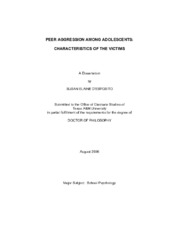| dc.description.abstract | Peer aggression is a significant problem among adolescents; it is
relatively common and frequently experienced among adolescents. Recently,
there has been growing attention to the occurrence and impact of bullying on
adolescent's well being at school. There is still a lot to learn about why certain
adolescents are targets for bullying. This study explores how certain personality
traits, behaviors, and social status may be predictors for those who are targeted
as victims of peer aggression. Students in three middle schools and one junior
high school from three different school districts in Texas were asked to
participate in this study. The sample consisted of 233 students. Students were
both males and females who were attending 6th, 7th, and 8th grade and were
between the ages of 12 and 15. Data was aggregated for each participating
student from demographic information collected from the Cover Sheet, with
participant demographics, Bullying/Victimization Scale (BVS), Behavior
Assessment System for Children - Self-Report (BASC-SRP), and Social
Support Scale for Children and Adolescents (Social Support - CFS). The data
obtained supported the expectation that adolescents who presented with symptoms of depression, anxiety, low self-esteem, high external locus of control,
low self-reliance, and high sense of inadequacy are more likely to become
victims of peer aggression than adolescents who are more socially competent,
more psychologically well-adjusted, and who have a higher internal locus of
control. Additionally, adolescents who show signs of social stress may also be
more likely to become victims of peer aggression. This is an important step in
the needed research because the victim is often overlooked when peer
aggression is occurring. Identification of potential victims and assistance with
development of their social skills may aid them in avoiding acts of peer
aggression. | en |


